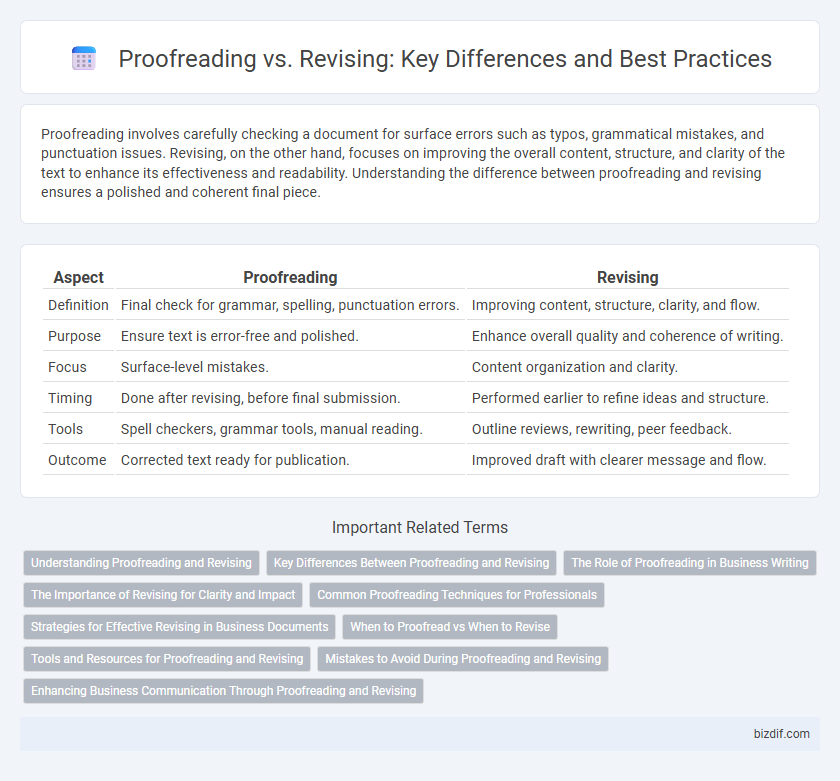Proofreading involves carefully checking a document for surface errors such as typos, grammatical mistakes, and punctuation issues. Revising, on the other hand, focuses on improving the overall content, structure, and clarity of the text to enhance its effectiveness and readability. Understanding the difference between proofreading and revising ensures a polished and coherent final piece.
Table of Comparison
| Aspect | Proofreading | Revising |
|---|---|---|
| Definition | Final check for grammar, spelling, punctuation errors. | Improving content, structure, clarity, and flow. |
| Purpose | Ensure text is error-free and polished. | Enhance overall quality and coherence of writing. |
| Focus | Surface-level mistakes. | Content organization and clarity. |
| Timing | Done after revising, before final submission. | Performed earlier to refine ideas and structure. |
| Tools | Spell checkers, grammar tools, manual reading. | Outline reviews, rewriting, peer feedback. |
| Outcome | Corrected text ready for publication. | Improved draft with clearer message and flow. |
Understanding Proofreading and Revising
Proofreading involves meticulously checking a text for surface errors such as grammar, spelling, punctuation, and formatting to ensure accuracy and clarity. Revising focuses on improving the overall content, structure, and flow of the writing by reorganizing ideas, refining arguments, and enhancing coherence. Understanding the distinction between proofreading and revising is essential for producing polished and effective written communication.
Key Differences Between Proofreading and Revising
Proofreading targets surface-level errors such as typos, punctuation mistakes, and formatting inconsistencies to ensure text accuracy. Revising involves substantial content changes, including reorganizing ideas, improving clarity, and enhancing argument strength for overall coherence. Understanding the distinction between proofreading and revising improves the effectiveness of the editing process.
The Role of Proofreading in Business Writing
Proofreading in business writing ensures error-free communication by identifying and correcting spelling, grammar, and punctuation mistakes that can undermine professionalism. It enhances clarity and credibility, making documents more persuasive and trustworthy to clients and stakeholders. Distinct from revising, which involves restructuring content for coherence and flow, proofreading focuses on polishing the final draft to maintain the company's polished image.
The Importance of Revising for Clarity and Impact
Revising is crucial for enhancing clarity and impact by refining sentence structure, improving word choice, and ensuring logical flow throughout the text. Unlike proofreading, which primarily targets surface-level errors such as typos and punctuation mistakes, revising delves deeper into content organization and coherence. Effective revision strengthens the overall message, making the writing more persuasive and easier to understand for the intended audience.
Common Proofreading Techniques for Professionals
Professional proofreading techniques emphasize meticulous attention to grammar, spelling, and punctuation errors to ensure textual accuracy. Utilizing tools like style guides, checklists, and software such as Grammarly helps maintain consistency and clarity throughout the document. Reading aloud and reviewing the text multiple times are effective strategies to detect overlooked mistakes and improve overall readability.
Strategies for Effective Revising in Business Documents
Effective revising in business documents involves focusing on clarity, coherence, and consistency to ensure the message aligns with organizational goals. Employing strategies such as reading aloud, seeking feedback from colleagues, and using revision checklists enhances the identification of logical gaps and tone issues. Prioritizing content restructuring before final proofreading ensures the business communication remains professional and impactful.
When to Proofread vs When to Revise
Proofreading should be done after revising to catch surface-level errors such as typos, punctuation, and formatting issues. Revising involves deeper changes to content, organization, and clarity, and is best performed earlier in the editing process. Prioritize revising when improving argument structure or adding information, then use proofreading for final error correction before publication.
Tools and Resources for Proofreading and Revising
Proofreading tools like Grammarly and Hemingway Editor highlight spelling, grammar, and punctuation errors, ensuring text accuracy and consistency. Revising software such as ProWritingAid and Scrivener offers advanced features for structural changes, style improvements, and content reorganization. Combining these resources enhances writing quality by targeting both surface-level mistakes and deeper content refinement.
Mistakes to Avoid During Proofreading and Revising
Mistakes to avoid during proofreading and revising include overlooking contextual errors, such as word choice or sentence structure, that affect clarity and coherence. Focusing solely on surface-level spelling or grammar mistakes without addressing overall flow or argument strength can compromise the quality of the final text. Ignoring feedback or rushing through the process often leads to missed errors and reduces the effectiveness of revision and proofreading efforts.
Enhancing Business Communication Through Proofreading and Revising
Proofreading and revising play distinct but complementary roles in enhancing business communication by ensuring clarity, accuracy, and professionalism. Revising focuses on improving the content's structure, coherence, and overall message to better engage the target audience, while proofreading eliminates grammatical errors, typos, and formatting inconsistencies to maintain credibility. Together, these processes optimize business documents, fostering clearer communication that drives stronger client relationships and business success.
Proofreading vs Revising Infographic

 bizdif.com
bizdif.com